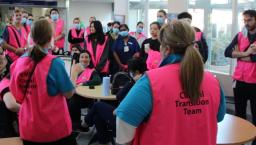Going beyond SDOH to reduce readmissions

Photo by: Ragnar Th Sigurdsson/Getty Images
There is a lot of emphasis on how social determinants of health data – strongly linked to patient outcomes – are used in real-world healthcare scenarios with many researchers focusing on a lack of standardization and the roadblocks it presents to health equity.
Because it was unclear if SDOH data are collected routinely and would facilitate exchange if captured in a structured format, the Office of the National Coordinator for Healthcare IT used nationally representative survey data from the 2022 American Hospital Association Information Technology supplement to gain insights into which non-federal acute care hospitals collect and receive data on individual patients’ health-related social needs and how the data is used, according to a briefing last month from ONC.
The agency found that 83% of U.S. acute care hospitals collect at least some SDOH, while 54% do it routinely. It also found that the top three uses of SDOH data are informing clinical decision-making, discharge planning and making referrals.
While ONC is focused on measuring providers’ use of screening instruments to identify opportunities "to increase the usage of validated and standardized screening tools that align with CMS guidance," using artificial intelligence and natural language processing to integrate SDOH information – as well as mental health and cultural factors – could help improve post-acute recovery, according to new research by the NorthShore Division of Cardiology and Laguna Health.
Their research looked at how patients with cardiovascular disease admitted to the hospital fared under a cafe management program that uses SDOH data but also considers "life context" to leverage behavior and emotional support and improve patient outcomes in the first 30 days after a hospital discharge.
The research report, published in the Journal of Healthcare Management July/August edition, found significant cost savings among those patients that received additional support – $1.1 million vs. $2.0 million – and a lower observed mean cost per readmitted patient – $44,052 vs. $91,278.
Dr. Mark Lampert, the deputy head of NorthShore's division of cardiology spoke with Healthcare IT News about how addressing life context – considerations beyond a patient's SDOH – helped to reduce total readmission costs among the study's participants.
Q. While screening can help healthcare organizations understand a patient's health-related social needs, effective utilization of collected data has been a challenge. How does a focus on "life context" improve a provider's understanding of emotional, behavioral and social factors that affect patient health and ultimately improve utilization?
A. Life context allows the provider to understand each patient’s unique circumstance, which involves their particular social, financial, behavioral and medical context.
These factors are often barriers to the patient’s recovery and are not detected during the hospital admission, in the discharge process, or in the short follow-up outpatient visit with their physician.
Q. How was behavioral and emotional support tailored to the patient's individual needs in the study?
A. When the patient engaged with the Laguna coach, an assessment of their behavioral and emotional needs was performed and barriers to recovery were identified. From there, strategies were employed to overcome the barriers or to provide professional direction if needed to approach each patient’s unique situation.
Q. The study suggests that the intervention is reproducible. How would technology help to scale the approach?
A. The intervention is aided by technology to alert coaches to their identification of barriers to recovery. Conversations are transcribed in real time using natural language processing, and artificial intelligence analyzes the conversation in real time.
When particular words are identified by AI during the conversation as potential barriers to recovery, the coach can be alerted and prompted to pursue the topic during the conversation. This will lead to a checklist of barriers that the coach and the patient will identify, and work together on solutions.
Q. How does AI help improve the efficacy of virtual care management platforms?
A. AI allows consistency when the intervention is scaled to a large number of coaches with a broad range of training and experience.
The software utilized by the Laguna intervention can be used to train the coaches, to document the conversations and findings of the coaches and to facilitate the efficacy of the interventions.
Q. Beyond testing interventions to improve the hospital-to-home transition, what are some other areas of care delivery that could benefit from providing individualized care using virtual platforms?
A. The intervention could have a broad range of applications, including chronic care management for diseases such as congestive heart failure, chronic pain, diabetes, chronic pulmonary disease, etc.
Andrea Fox is senior editor of Healthcare IT News.
Email: afox@himss.org
Healthcare IT News is a HIMSS Media publication.
























